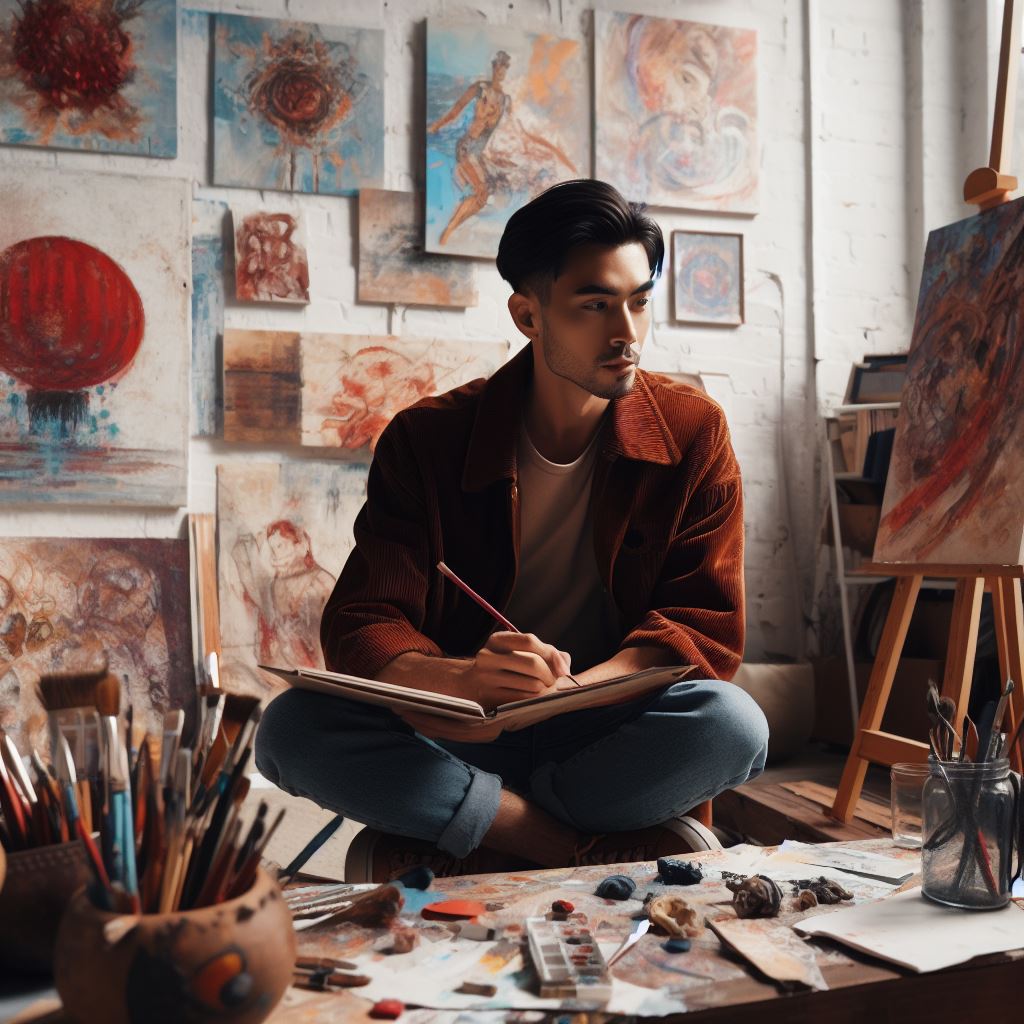Introduction
The US art market holds immense significance for emerging artists, serving as a crucial platform for exposure and success.
Navigating this dynamic landscape, however, poses formidable challenges. Emerging artists encounter hurdles such as fierce competition, establishing their brand, and breaking into established galleries.
This section unveils essential strategies to empower artists in conquering these obstacles and flourishing in the intricate realm of the US art market.
Understanding the US Art Market
The size and diversity of the US art market
- The US art market is one of the largest and most diverse in the world.
- It encompasses various forms of art including paintings, sculptures, photography, and more.
- Artists from all over the world aim to establish themselves in the US art market due to its vast opportunities.
- Galleries, auction houses, and online platforms play a crucial role in the growth of the market.
Analysis of different segments within the market (e.g., galleries, auction houses, online platforms)
- Galleries: These physical spaces exhibit and sell artworks. They provide a platform for emerging artists to showcase their talent.
- Auction houses: These organizations hold public sales where artworks are bid on by collectors and art enthusiasts.
- Online platforms: With the rise of technology, artists now have the option to sell their art on various online platforms.
- Each segment has its own advantages and disadvantages. Artists can choose the one that aligns with their goals.
Overview of key players and influencers in the US art market
- Artists: They are the creators who drive the art market with their unique and innovative works.
- Collectors: These individuals have a significant influence on the market as they invest in artworks and support artists.
- Curators: They play a vital role in organizing exhibitions and selecting artworks for galleries or museums.
- Art critics: Their opinions and reviews influence the perception and value of art in the market.
- Institutions: Museums, educational organizations, and government bodies contribute to the development and preservation of art.
- Influencers: Social media influencers have gained prominence in the art world, shaping trends and promoting artists.
In general, the US art market is a vast and diverse landscape with numerous opportunities for emerging artists.
Understanding its size, segments, and key players is essential for navigating through this competitive industry.
Artists can choose to collaborate with galleries, auction houses, or explore online platforms based on their individual goals and aspirations.
Additionally, building relationships with collectors, curators, critics, and influencers can significantly impact an artist’s success in the market.
By comprehending the intricacies of the US art market, emerging artists can position themselves for growth and recognition.
Read: Tax & Finances: Navigating Business for Photographers in the US
Building a Strong Artistic Identity
Recognizing and honing one’s artistic style and voice
- Experiment with different techniques and mediums to discover your unique style.
- Study art history to understand different artistic movements and find inspiration.
- Analyze your own artwork to identify recurring themes, motifs, and subjects.
- Seek feedback from mentors, peers, and art critics to gain insights into your work.
- Constantly refine and develop your skills to strengthen your artistic voice.
Developing a cohesive body of work
- Choose a consistent theme or concept to unify your artworks.
- Explore different variations and perspectives within your chosen theme.
- Create a series of artworks that demonstrate depth and exploration of your chosen concept.
- Ensure that each artwork contributes to the overarching narrative of your body of work.
- Display your artworks together to create a cohesive and impactful presentation.
Building an online presence and portfolio
- Create a professional website or online portfolio to showcase your artwork.
- Use high-quality images and provide detailed descriptions for each artwork.
- Regularly update your online portfolio with new artworks and exhibitions.
- Engage with the online art community, share your process, and network with other artists.
- Optimize your website for search engines to increase your visibility.
Crafting a robust artistic identity is vital for emerging artists navigating the US art market successfully. Hone your unique style by experimenting with techniques, studying art history, and seeking feedback.
Define your voice and create a cohesive body of work around a consistent theme. Showcase your art globally through a professional website, ensuring high-quality images and engaging descriptions.
Regularly update your portfolio and engage with the online art community to gain visibility. Optimize your website for search engines using relevant keywords and valuable content.
Leverage social media platforms like Instagram to extend your reach and connect with a broader audience.
Building a strong artistic identity involves recognizing your style, creating a cohesive body of work, and establishing an online presence.
Invest in these areas to attract local and international attention, increasing your chances of success in the US art market.
Read: Freelance vs. Agency: Career Paths for US Photographers
Building Relationships in the Art World
Networking strategies for emerging artists
- Attend art industry events and conferences to meet influential people.
- Join online art communities and forums to connect with fellow artists.
- Utilize social media platforms to showcase your work and interact with potential collaborators.
- Participate in workshops and seminars to expand your knowledge and meet like-minded individuals.
- Reach out to established artists for mentorship opportunities or advice on navigating the art market.
Leveraging connections with fellow artists, gallery owners, and art collectors
- Cultivate genuine relationships with fellow artists to learn from their experiences and gain support.
- Attend gallery openings and exhibitions to meet gallery owners and establish connections.
- Engage with art collectors by showcasing your work in galleries or participating in art fairs.
- Maintain regular communication with your network by sharing updates on your artistic journey.
- Collaborate with other artists on projects to expand your reach and showcase your versatility.
Participating in art events, exhibitions, and artist residencies
- Apply for art competitions and grants to gain recognition and exposure.
- Submit your work to juried exhibitions to showcase your talent to a larger audience.
- Participate in artist residencies to immerse yourself in a creative environment and connect with fellow artists.
- Attend art festivals and fairs to explore new trends, meet art professionals, and expand your network.
- Seek opportunities to give talks or presentations about your art to establish yourself as an expert in your field.
Building relationships in the art world is crucial for emerging artists looking to establish themselves and succeed in the competitive art market.
Networking, leveraging connections, and actively participating in art events are effective strategies to expand your network, gain exposure, and open doors to new opportunities.
Networking strategies for emerging artists
Emerging artists should make an effort to attend art industry events and conferences where they can meet influential people who can assist in their artistic journey.
By networking with art professionals, aspiring artists can gain insights into the inner workings of the art market and learn from experienced individuals.
Transform Your Career Today
Unlock a personalized career strategy that drives real results. Get tailored advice and a roadmap designed just for you.
Start NowAdditionally, joining online art communities and forums allows artists to connect with like-minded individuals, exchange ideas, and potentially collaborate on future projects.
Social media platforms are also valuable tools for showcasing artwork, engaging with potential collaborators, and growing a supportive community of art lovers.
Leveraging connections with fellow artists, gallery owners, and art collectors
Developing personal relationships with other artists and industry insiders can significantly impact an emerging artist’s career.
By cultivating genuine friendships with fellow artists, artists can establish a support system and gain valuable advice from individuals who have navigated the art market successfully.
Attending gallery openings and exhibitions provides opportunities to meet gallery owners, who can introduce an artist’s work to a wider audience.
Engaging with art collectors is equally important, as they are potential buyers and promoters of an artist’s work.
Collaborating with other artists on joint projects is a great way to showcase artistic versatility and reach a broader audience.
Participating in art events, exhibitions, and artist residencies
Actively participating in art events, exhibitions, and artist residencies is a vital step for emerging artists to gain recognition and exposure.
Applying for art competitions and grants can provide valuable opportunities to showcase talent and attract the attention of art professionals.
Submitting work to juried exhibitions ensures that the artwork is seen by a larger audience, potentially leading to sales and further opportunities.
Artist residencies offer an immersive experience in a creative community, providing opportunities to collaborate and learn from fellow artists.
Attending art festivals and fairs allows artists to stay updated on the latest trends, connect with art professionals, and expand their network.
Giving talks or presentations about one’s art can establish artists as experts in their field and generate interest in their work.
In essence, artists need to actively build relationships in the art world to navigate the US art market successfully.
By employing networking strategies, leveraging connections with artists, gallery owners, and art collectors, and participating in various art events, exhibitions, and artist residencies, emerging artists can expand their network and gain valuable exposure.
Building relationships is not just about promoting one’s work but also about fostering genuine connections and learning from individuals who have already achieved success in the art world.
Read: Photography Ethics & Etiquette: Standards in the USA

Navigating the Gallery System
Understanding the gallery landscape in the US
The US art market has a diverse range of galleries, including commercial galleries, non-profit spaces, and artist-run cooperatives.
These galleries vary in their size, reputation, and focus, which artists should consider when navigating the gallery system.
Understanding the different types of galleries can help emerging artists identify the best fit for their artistic practice.
Transform Your Career Today
Unlock a personalized career strategy that drives real results. Get tailored advice and a roadmap designed just for you.
Start NowResearching and approaching galleries that align with one’s artistic vision and goals
Researching galleries before approaching them is crucial to ensure compatibility and increase the chances of acceptance.
Artists should consider factors like the gallery’s specialization, curatorial preferences, and their reputation in the art world.
It’s important to choose galleries that align with one’s artistic vision and goals to establish a fruitful partnership.
Preparing a professional portfolio and artist statement to present to galleries
Artists should curate a professional portfolio that showcases their best work and reflects their unique style and artistic voice.
It’s essential to present a cohesive body of work that demonstrates technical proficiency and conceptual depth.
Additionally, artists should craft a compelling artist statement that provides insight into their process, inspiration, and artistic intentions.
A well-prepared portfolio and artist statement can create a strong impression and capture the attention of gallery representatives.
Consistency, professionalism, and attention to detail are paramount in this competitive field.
Reaching out to galleries through effective communication
When approaching galleries, artists should craft a personalized and concise email introducing themselves and their work.
They should highlight relevant achievements and explain why their art would be a good fit for the gallery.
Artists must follow each gallery’s submission guidelines and provide any additional requested materials.
It is crucial to be respectful of the gallery’s time and not to overwhelm them with excessive information.
A clear and respectful communication approach can go a long way in establishing positive relationships with galleries.
Building relationships with galleries and staying connected
Building relationships with galleries is an ongoing process that requires active engagement and participation.
Artists should attend gallery openings, art fairs, and local events to network, meet gallery owners, and establish connections.
Maintaining regular contact through email or social media can also help nurture relationships with galleries over time.
Collaboration and mutual support are key in the gallery system, as fostering long-term relationships can lead to successful representation.
Remember that patience and persistence are essential, as the process of securing gallery representation may take time.
Navigating the gallery system in the US art market can be challenging but rewarding for emerging artists.
By understanding the gallery landscape, conducting thorough research, preparing a professional portfolio and artist statement, approaching galleries effectively, and building lasting relationships, artists can enhance their visibility and reach their career goals.
Transform Your Career Today
Unlock a personalized career strategy that drives real results. Get tailored advice and a roadmap designed just for you.
Start NowRead: US Photographer‘s Toolkit: Essential Gear for Professionals
Exploring Alternative Sales Channels
Utilizing online art platforms and marketplaces
As an emerging artist, one of the most effective ways to navigate the US art market is by leveraging the power of online art platforms and marketplaces.
These platforms provide a convenient and accessible way for artists to showcase and sell their artworks to a global audience.
Online platforms such as Artsy, Saatchi Art, and Etsy allow artists to create their own virtual galleries, upload high-quality images of their artworks, and provide detailed descriptions and pricing information.
These platforms also offer various marketing and promotional tools to help artists reach a wider audience and increase their visibility in the art market.
Moreover, online art platforms often have established networks and relationships with collectors, art consultants, and curators, which can greatly benefit emerging artists who are looking to connect with potential buyers and establish professional relationships in the art industry.
Considering art fairs and pop-up exhibitions
Art fairs and pop-up exhibitions offer another alternative sales channel for emerging artists to navigate the US art market.
These events provide a physical space for artists to showcase their artworks and directly interact with potential buyers and collectors.
Art fairs, such as Art Basel and Frieze, are prestigious events that attract international collectors, art enthusiasts, and industry professionals.
Participating in these art fairs can provide valuable exposure and opportunities for emerging artists to gain recognition in the art market.
Pop-up exhibitions, on the other hand, offer a more informal and temporary setting for artists to display their artworks.
These exhibitions often take place in unconventional locations such as unused storefronts, warehouses, or public spaces.
Collaborating with other artists or art organizations to organize pop-up exhibitions can help generate buzz and attract a diverse audience.
Collaborating with non-traditional partners
Emerging artists can also explore collaborating with non-traditional partners to expand their reach in the US art market.
Building relationships with interior designers, restaurants, businesses, or other creative professionals can open up new sales opportunities and introduce artwork to different audiences.
Interior designers often work closely with clients who are looking to enhance their spaces with art.
By partnering with interior designers, artists can have their artworks considered for residential or commercial projects, providing a steady source of income and exposure.
Restaurants and businesses, particularly those with a focus on art and design, can provide unique exhibition spaces for artists to showcase their artworks.
These collaborations can bring exposure to a diverse group of potential buyers who may not typically visit traditional art galleries or museums.
Ultimately, exploring alternative sales channels is crucial for emerging artists to navigate the US art market successfully.
Transform Your Career Today
Unlock a personalized career strategy that drives real results. Get tailored advice and a roadmap designed just for you.
Start NowOnline platforms, art fairs, pop-up exhibitions, and collaborations with non-traditional partners can all provide valuable opportunities to showcase and sell artworks, connect with buyers, and establish a presence in the art industry.
Pricing, Valuation, and Negotiation
Strategies for setting fair and competitive prices for artwork
- Research similar artworks in terms of style, size, and medium to gauge market prices.
- Consider factors like your experience, reputation, and demand for your work when setting prices.
- Take into account the time, effort, and cost of materials involved in creating each artwork.
- Don’t undervalue your work, but also avoid overpricing it as it may deter potential buyers.
- Regularly reassess and adjust your prices based on market trends and feedback from collectors.
Understanding the valuation process and factors that determine the value of art
- Art valuation involves assessing an artwork’s quality, condition, rarity, and historical importance.
- Factors such as the artist’s reputation, exhibition history, and public recognition can influence value.
- Art market trends, demand, and the availability of comparable artworks also affect the valuation.
- Consider consulting experts or appraisers who have extensive knowledge of the art market.
- Remember that an artwork’s value may fluctuate over time, so stay informed about market changes.
Tips for negotiating contracts, commissions, and pricing with galleries and collectors
- Before entering into any negotiation, research and familiarize yourself with industry standards.
- Clearly establish your pricing structure, including the percentage for gallery commissions or agent fees.
- Ensure that all terms, deadlines, and responsibilities are clearly stated in written agreements.
- Consider seeking legal advice when negotiating complex contracts to protect your rights and interests.
- Maintain open communication and professional relationships with galleries and collectors during negotiations.
Protecting and Promoting One’s Artwork
Understanding copyright and intellectual property rights
As an emerging artist, it is vital to have a clear understanding of copyright and intellectual property rights.
These rights protect your original creations from being used or copied without your permission.
By obtaining copyrights for your artworks, you can legally prevent others from reproducing, distributing, or displaying your art without authorization.
Securing proper insurance coverage for artwork
Protecting your artwork goes beyond legal rights; it also involves safeguarding it physically. Securing proper insurance coverage is crucial in case of theft, damage, or loss.
Art insurance offers financial protection for your valuable pieces, ensuring that you can recover their value or receive compensation in the event of an unfortunate incident.
Promoting and marketing one’s artwork through various channels
Once you have taken steps to protect your artwork, it’s time to promote and market it effectively. Utilizing various channels for promotion is essential to reach a wider audience and attract potential buyers.
Social media platforms like Instagram, Facebook, and Twitter can be used to showcase your art, connect with art enthusiasts, and gain exposure.
Additionally, press releases can play a significant role in generating publicity for your art.
Writing compelling press releases and sending them to relevant media outlets can help you reach art critics, journalists, and potential buyers.
Make sure your press releases highlight your unique artistic style, achievements, and upcoming exhibitions.
Art publications are also valuable resources for promoting your artwork. Research and submit your works to be featured in prestigious art magazines, journals, or online galleries.
Being published in recognized publications not only boosts your credibility as an artist but also increases your visibility within the art community.
Generally, protecting and promoting your artwork requires a multi-faceted approach. By understanding copyright and intellectual property rights, you can legally safeguard your creations.
Securing proper insurance coverage provides financial protection, while effective promotion through channels like social media, press releases, and art publications helps you gain exposure and attract potential buyers.
By implementing these strategies, you can navigate the US art market as an emerging artist with confidence and success.
Learn More: The Future of UX/UI Design: Predictions for 2025
Diversifying Income Streams
In order to navigate the US art market successfully and establish a sustainable career, emerging artists must explore various sources of income.
Relying solely on the sale of artwork may not always be sufficient, especially in the early stages.
Exploring other sources of income for emerging artists
- Freelance work: Consider taking on freelance projects that align with your artistic skills. This could include commissioned pieces, graphic design, or illustration work.
- Art-related services: Offer services such as art curation, art consultation, or art restoration. These services can provide a steady income stream while still being closely related to your artistic practice.
- Art commissions: Actively seek out commission opportunities from individuals, businesses, or organizations who are interested in having custom artwork created.
This allows you to work on specific projects while earning a fee. - Art licensing: Explore licensing your artwork for use in various commercial products or collaborations with brands. This could include merchandise, apparel, or home decor items that feature your art.
Teaching art classes or workshops
- Share your knowledge: Consider offering art classes or workshops to individuals who are interested in learning from you.
This allows you to not only earn income but also gives you the opportunity to share your artistic expertise. - Choose your format: Decide whether you want to teach in-person classes, online courses, or both. Online platforms have made it easier than ever to reach a global audience and generate income from teaching.
- Collaborate with institutions: Approach local art schools, community centers, or galleries to inquire about teaching opportunities.
They may be interested in hiring you as a guest instructor or incorporating your classes into their curriculum. - Create instructional content: Consider creating instructional videos, e-books, or tutorials that aspiring artists can purchase. This allows you to generate passive income while reaching a larger audience.
Licensing artwork for commercial purposes
- Understand licensing agreements: Educate yourself on the basics of licensing artwork to ensure you protect your rights and receive fair compensation.
Consider consulting with a lawyer or joining a professional organization for guidance. - Reach out to potential clients: Identify businesses or brands that align with your artistic style and reach out to them with a proposal for licensing your artwork. Highlight the value and uniqueness of your creations.
- Negotiate terms: When entering into licensing agreements, carefully negotiate the terms and royalties involved. Consider factors such as exclusivity, duration, and compensation to ensure a mutually beneficial partnership.
- Market your licensed products: Collaborate with the licensee to effectively market the licensed products featuring your artwork. Utilize social media, online marketplaces, and art events to maximize exposure and increase sales.
By diversifying their income streams, emerging artists can gain financial stability while still focusing on their artistic practice.
Transform Your Career Today
Unlock a personalized career strategy that drives real results. Get tailored advice and a roadmap designed just for you.
Start NowExploring different sources of income, teaching art classes or workshops, and licensing artwork for commercial purposes are all viable ways to expand revenue opportunities.
Uncover the Details: US Interior Designers: From Freelance to Firm Employment
Explore Further: Trends in Landscape Art and Design for Public Spaces
Conclusion
Recap of key tips and strategies for navigating the US art market
After exploring various tips and strategies for emerging artists in navigating the US art market, it’s important to recap the key takeaways.
First, artists should focus on building a strong portfolio showcasing their unique style and creativity.
Second, networking and building relationships with galleries, collectors, and curators can open doors to new opportunities.
Investing time and effort in promotional activities such as participating in art fairs and exhibitions, as well as leveraging social media platforms, can significantly increase visibility and reach.
Additionally, artists should consider collaborating with other artists and participating in artist residencies or grant programs to gain recognition and support for their work.
Encouragement for emerging artists to persevere and stay motivated in their journey
For emerging artists, navigating the US art market can be challenging, but it’s crucial to stay motivated and persevere.
Rejection and setbacks are common in the art world, but they should be seen as opportunities for growth and learning.
Surrounding oneself with a supportive community of artists and mentors can provide invaluable guidance and encouragement.
Remember that success in the art market takes time and continuous dedication. It’s important to stay true to one’s artistic vision and maintain a strong work ethic.
By staying motivated and constantly pushing boundaries, emerging artists can carve their path towards success.
Final thoughts on the potential rewards of successfully navigating the US art market
Successfully navigating the US art market can bring immense rewards for emerging artists. It can lead to increased recognition, opportunities for collaborations and exhibitions, and ultimately, financial stability.
Establishing a strong presence in the art market can open doors to international exposure and prestigious accolades.
However, artists should remember that the journey itself is a rewarding experience. The process of self-discovery, personal growth, and artistic development that comes with navigating the art market is invaluable.
Regardless of the outcome, artists should embrace the challenges and continue pushing their boundaries, as every step forward brings them closer to achieving their artistic goals.
[E-Books for Sale]
The Big Book of 500 High-Paying Jobs in America: Unlock Your Earning Potential
$19.99 • 500 High-Paying Jobs • 330 pages
Explore 500 high-paying jobs in America and learn how to boost your career, earn more, and achieve success!
See All 500 High-Paying Jobs of this E-Book
1001 Professions Without a Degree: High-Paying American Jobs You Can Start Now
$19.99 • 1001 Professions Without a Degree • 174 pages
Discover 1001 high-paying jobs without a degree! Unlock career tips, skills, and success strategies for just $19.99!




